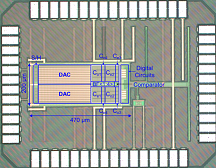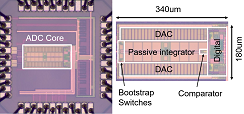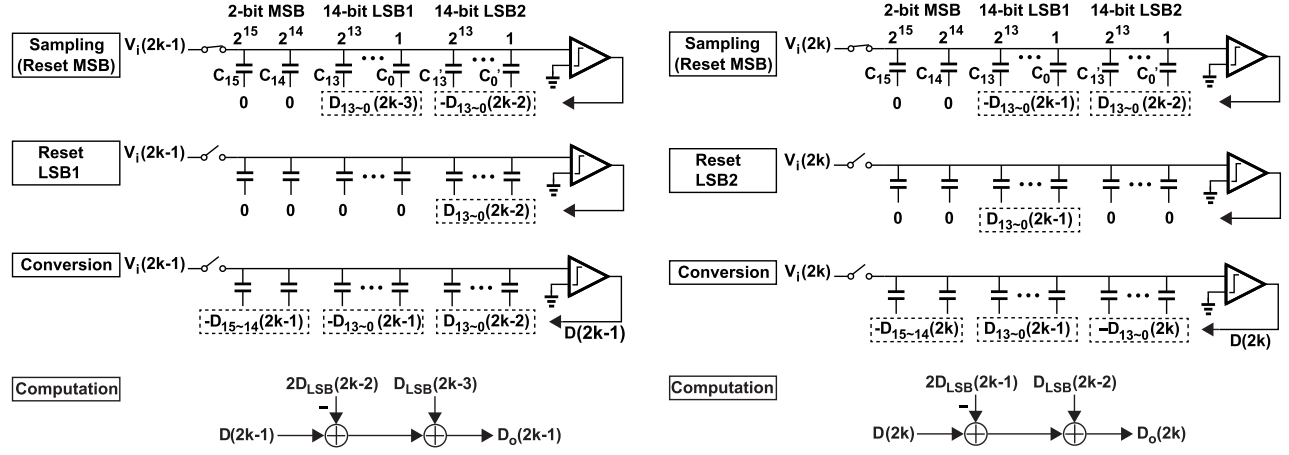1. 基于电容叠加与缓冲的新型积分器及噪声整形SAR ADC芯片 [ISSCC 2021]

The prior noise-shaping SAR ADCs rely on closed-loop charge transferring or passive charge sharing. The former is power consuming, and the latter suffers from limited noise suppression or PVT variation. In this work, we propose an efficient new integrator technique. This integrator doesn’t require any amplifier, thus is power efficient and PVT robust. It also avoids the large signal attenuation caused by passive charge sharing, therefore it can build a noise-shaping SAR ADC with sharp NTF and strong noise suppression. It has low hardware complexity, and is easy for high order extension. A 4th-order noise-shaping SAR ADC is realized based on this integrator. It measures 93dB SNDR over 250kHz bandwidth with 340uW power consumption, leading to a schreier FoM of 182dB.
2. 实现采样kT/C噪声抵消的ADC芯片 [ISSCC 2020, JSSC 2020]

As any ADC with a front-end S/H, SAR ADC suffers from a fundamental SNR challenge: its sampling kT/C noise. To satisfy the SNR requirement, the input capacitor has to be sufficiently large. This work presents a SAR ADC with a kT/C noise cancellation technique. It enables the substantial reduction of ADC input capacitance but without large kT/C noise penalty, greatly relaxing the requirement for the ADC input driver and reference buffer.
3. 实现无源增益噪声整形和二阶失配误差整形的SAR ADC芯片 [ISSCC 2020-1, JSSC 2021]

This work presents a 90dB-SNDR passive NS SAR with 2nd-order mismatch error shaping. It has an efficient architecture that removes the residue sampling and realizes 4× passive gain, leading to reduced total kT/C and comparator noise. Moreover, it realizes 2nd-order MES that is tone-free and supports full input range.
4. 集成NS-SAR量化器的CT-DT混合结构ΔΣ ADC [VLSI 2018, JSSC 2019]

This work presents a compact and power efficient third-order continuous-time (CT) Delta-Sigma (∆Σ) ADC with a single OTA. A 4-bit second-order fully passive noise-shaping SAR ADC is employed as the quantizer while inherently provides two additional noise shaping orders.
5. 高阶失配误差整形与数字预测的理论研究工作 [TCAS-I 2019]

Device mismatch is a key concern for high-resolution data converters. This work presents a comprehensive study of the error-feedback (EF)-based mismatch error shaping (MES) technique. EF MES overcomes the key challenge of the classic dynamic element matching-based MES whose complexity grows exponentially with the number of bits; however, the prior EF MES comes with the limitations of limited shaping capability and reduced dynamic range. This paper demonstrates how to perform more advanced EF MES for various types of data converters. Moreover, this paper also proposes the use of digital prediction to address the dynamic range loss issue.
刘佳欣,电子科技大学“百人计划”特聘研究员、博士生导师。
本科毕业于山东大学,硕博毕业于电子科技大学,美国德州大学奥斯汀分校联合培养博士生,清华大学博士后。
主要研究领域为模拟与混合信号集成电路设计,具体的研究兴趣包括但不限于:(1)数据转换器(ADC/DAC)芯片的设计;(2)物联网、传感器专用集成电路(ASIC)设计。先后主持国家自然科学基金青年、面上等项目,参与国家自然科学基金重点、重大项目、国家重点研发计划等项目数项。在芯片设计领域发表论文50余篇,其中顶级会议ISSCC和期刊JSSC论文20余篇。授权中国发明专利10余项,授权美国专利3项。担任IEEE TCAS-II等多个期刊编委及会议TPC委员。
Google Scholar: https://scholar.google.com.hk/citations?user=CE7PYu4AAAAJ&hl=zh-CN
通讯/办公地址 : 5861765090bee7ffcee626fac26a379c839b0adf9a80b2cd0554f5a6815193c20966feebc1f1ffa57a636757b8bccab27cdc0865b7167f20d75ae35fc697ef33285c82cce939908e35b67426f45b542446c47842e6e4e117e286f14b2ba3568543d93eddb3a23a070daaeb16c2dc2e0545404e0f6990c99fdf505fb64b15a539
邮箱 : ba06b93da322f1b144da15dacf88497946fea84ef07d2a50c704c69b670e496bb9d0b2fa10170cc2a8d9f21a0c9f1bf11535a2e9e9710af31dcc95ca69ef33aa93b425c861e0f46ec193be8cf4d568d730789155135a3f8ea7c96c47f97fa956a4f2c596865df2821230a7d3c8a385fe9093632627f4353f32b08cf4df40d105